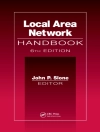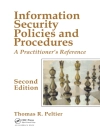Prep for success on the Network+ N10-008 exam and for your new career in network administration with this must-have resource
In the newly updated Fifth Edition of the Comp TIA Network+ Review Guide: Exam: N10-008, a leading expert in Network Operations, Jon Buhagiar, delivers a focused and concise handbook for anyone preparing for the new Network+ N10-008 exam or for a career in network administration.
This guide is organized into five parts, with each part corresponding to one of the 5 objective domain areas of the Network+ exam: Fundamentals, Implementations, Operations, Security, and Troubleshooting.
You’ll handily learn crucial IT skills like designing and implementing functional networks, configuring and managing essential network devices, using switches and routers to segment network traffic, and securing existing networks. This book also allows you to:
- Quickly and comprehensively prepare for the Network+ N10-008 exam with intuitively organized info and efficient learning strategies
- Discover the skills and techniques required in an entry-level network administration interview and job
- Access the Sybex online learning center, with chapter review questions, full-length practice exams, hundreds of electronic flashcards, and a glossary of key terms
Perfect as a standalone resource for those seeking to succeed on the Comp TIA Network+ N10-008 exam or as a companion to the Comp TIA Network+ Study Guide and Comp TIA Network+ Deluxe Study Guide, this book is an indispensable reference for anyone preparing for a career in network administration, network analysis, or systems engineering.
Innehållsförteckning
Introduction xvii
Chapter 1 Domain 1.0: Networking Fundamentals 1
1.1 Compare and contrast the Open Systems Interconnection (OSI) model layers and encapsulation concepts 11
OSI Model 12
Protocol Data Units 21
Data Encapsulation and Decapsulation 22
Exam Essentials 26
1.2 Explain the characteristics of network topologies and network types 28
Wired Topologies 28
Types 33
Service- Related Entry Point 39
Virtualization 40
Virtual Networking Components 40
Service Type 43
Service Delivery 48
Exam Essentials 50
1.3 Summarize the types of cables and connectors and explain which is the appropriate type for a solution 51
Media Types 51
Connector Types 55
Transceivers 60
Media Converters 62
Characteristics of Fiber Transceivers 63
Termination Points 65
Copper Cabling Standards 70
Copper Termination Standards 73
Ethernet Deployment Standards 76
Exam Essentials 78
1.4 Given a scenario, configure a subnet and use appropriate IP addressing schemes 80
Private vs. Public 80
Nat/pat 81
IPv4 Concepts 84
IPv6 Concepts 88
Address Assignments 93
Subnetting 99
Virtual IP (VIP) 107
Exam Essentials 108
1.5 Explain common ports and protocols, their application, and encrypted alternatives 110
Protocols and Ports 110
IP Protocol Types 117
Connection- Oriented vs. Connectionless 121
Exam Essentials 122
1.6 Explain the use and purpose of network services 123
Dns 123
DHCP Service 132
Ntp 137
Exam Essentials 137
1.7 Explain basic corporate and datacenter network architecture 139
Three- Tiered Model 139
Software- Defined Networking 140
Spine and Leaf 142
Traffic Flows 143
Host Locations 144
Network Storage Types 145
Connection Type 147
Exam Essentials 150
1.8 Summarize cloud concepts and connectivity options 151
Characteristics of a Cloud 151
Cloud Delivery Models 152
Types of Services 155
Infrastructure as Code 157
Connectivity Methods 160
Multitenancy 161
Elasticity 161
Scalability 162
Security Implications/Considerations 162
Relationship Between Local and Cloud Resources 163
Exam Essentials 163
Review Questions 165
Chapter 2 Domain 2.0: Network Implementations 169
2.1 Compare and contrast various devices, their features, and their appropriate placement on the network 173
Network Devices 173
Exam Essentials 203
2.2 Compare and contrast routing technologies and bandwidth management concepts 204
Routing 204
Bandwidth Management 212
Exam Essentials 215
2.3 Given a scenario, configure and deploy common Ethernet switching features 216
Characteristics of Ethernet and IP Communications 216
Basic Switch Functions 220
Segmentation and Interface Properties 227
Switching Features 231
Exam Essentials 234
2.4 Given a scenario, install and configure the appropriate wireless standards and technologies 235
802.11 Standards 235
Frequencies 238
Wireless Considerations 239
Wireless Modes of Operation 245
Wireless Security 248
Cellular 252
Exam Essentials 254
Review Questions 256
Chapter 3 Domain 3.0: Network Operations 261
3.1 Given a scenario, use the appropriate statistics and sensors to ensure network availability 265
Performance Metrics 265
Snmp 270
Network Device Logs 274
Interface Statistics/Status 279
Interface Errors or Alerts 286
Environmental Factors and Sensors 289
Performance Baselines 291
Net Flow Data 292
Uptime/Downtime 293
Exam Essentials 294
3.2 Explain the purpose of organizational documents and policies 296
Plans and Procedures 296
Hardening and Security Policies 303
Common Documentation 307
Common Agreements 315
Exam Essentials 316
3.3 Explain high availability and disaster recovery concepts and summarize which is the best solution 318
Load Balancing 318
Multipathing 318
Network Interface Card (NIC) Teaming 320
Redundant Hardware/Clusters 320
Facilities and Infrastructure Support 326
Redundancy and High Availability (HA) Concepts 330
Backups 334
Exam Essentials 336
Review Questions 338
Chapter 4 Domain 4.0: Network Security 343
4.1 Explain common security concepts 348
Confidentiality, Integrity, Availability (CIA) 348
Threats 349
Vulnerabilities 350
Exploits 351
Least Privilege 351
Role- Based Access 352
Zero Trust 352
Defense in Depth 353
Authentication Methods 357
Security Assessments 364
Security Information and Event Management (SIEM) 366
Exam Essentials 366
4.2 Compare and contrast common types of attacks 368
Technology- Based 368
Human and Environmental 378
Exam Essentials 379
4.3 Given a scenario, apply network hardening techniques 381
Best Practices 381
Wireless Security 390
IOT Considerations 395
Exam Essentials 396
4.4 Compare and contrast remote access methods and security implications 397
Vpn 397
Remote Desktop Connection 400
Remote Desktop Gateway 401
Ssh 401
Virtual Network Computing (VNC) 402
Virtual Desktop 402
Authentication and Authorization Considerations 403
In- Band vs. Out- of- Band Management 403
Exam Essentials 405
4.5 Explain the importance of physical security 406
Detection Methods 407
Prevention Methods 410
Asset Disposal 413
Exam Essentials 415
Review Questions 416
Chapter 5 Domain 5.0: Network Troubleshooting 421
5.1 Explain the network troubleshooting methodology 427
Identify the Problem 428
Establish a Theory of Probable Cause 430
Test the Theory to Determine the Cause 431
Establish a Plan of Action to Resolve the Problem and Identify Potential Effects 432
Implement the Solution or Escalate as Necessary 432
Verify Full System Functionality and, If Applicable, Implement Preventive Measures 433
Document Findings, Actions, Outcomes, and Lessons Learned 433
Exam Essentials 433
5.2 Given a scenario, troubleshoot common cable connectivity issues and select the appropriate tools 434
Specifications and Limitations 434
Cable Considerations 435
Cable Application 437
Common Issues 439
Common Tools 445
Exam Essentials 456
5.3 Given a scenario, use the appropriate network software tools and commands 458
Software Tools 458
Command- Line Tools 466
Basic Network Platform Commands 481
Exam Essentials 485
5.4 Given a scenario, troubleshoot common wireless connectivity issues 486
Specifications and Limitations 486
Considerations 489
Common Issues 493
Exam Essentials 498
5.5 Given a scenario, troubleshoot general networking issues 499
Considerations 499
Common Issues 501
Exam Essentials 530
Review Questions 532
Appendix Answers to Review Questions 537
Chapter 1: Domain 1.0: Networking Fundamentals 538
Chapter 2: Domain 2.0: Network Implementations 541
Chapter 3: Domain 3.0: Network Operations 544
Chapter 4: Domain 4.0: Network Security 547
Chapter 5: Domain 5.0: Network Troubleshooting 550
Index 553
Om författaren
ABOUT THE AUTHOR
Jon Buhagiar, Network+, A+, CCNA, MCSA, MCSE, BS/ITM, is Supervisor of Network Operations at Pittsburgh Technical College. In addition to teaching, he has been creating course content for the past 20 years. Some of his more recent work can be found on You Tube http://www.youtube.com/networkedminds.












